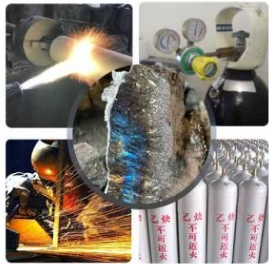
In the global B2B chemical export industry, calcium carbide stands as a crucial raw material with wide - ranging applications. However, its storage and transportation are fraught with potential safety hazards. Understanding these risks and how to mitigate them is essential for industry players to ensure safe and efficient production.
Calcium carbide (CaC₂) is a chemical compound that reacts vigorously with water. When calcium carbide comes into contact with water, it undergoes a chemical reaction: CaC₂ + 2H₂O → C₂H₂↑+ Ca(OH)₂. The product, acetylene gas (C₂H₂), is highly flammable and explosive. With an explosion limit in air ranging from 2.5% to 80%, even a small spark can trigger a violent explosion. This makes the presence of water during storage and transportation a major threat.
Another concern is the presence of impurities in calcium carbide. Many calcium carbide products contain calcium phosphide (Ca₃P₂). When calcium phosphide reacts with water, it releases phosphine gas (PH₃), which is extremely toxic. Inhaling a small amount of phosphine can cause symptoms such as dizziness, nausea, and in severe cases, it can be fatal. According to industry statistics, improper handling of calcium carbide due to these impurities has led to numerous accidents in the past few decades.
Calcium carbide is mainly used in the production of acetylene for welding and cutting, as well as in the synthesis of various organic compounds in the chemical industry. Its wide - spread use makes safety in its handling all the more important.

As mentioned earlier, water contact can lead to acetylene explosion and phosphine release. A real - life example is a storage accident in a chemical plant in [Year]. Due to a roof leak during heavy rain, water seeped into the calcium carbide storage area, causing a series of small explosions and releasing toxic phosphine gas. To prevent this, strict waterproof measures should be in place during storage, such as storing calcium carbide in sealed containers in a dry and well - ventilated warehouse.
High - impurity calcium carbide increases the risk of phosphine release. Before purchasing and using calcium carbide, it is necessary to conduct a comprehensive component analysis. For example, reputable suppliers like Inner Mongolia Longwei Chemical Technology Co., Ltd. offer high - purity calcium carbide with strict quality control, reducing the content of calcium phosphide and other harmful impurities to a minimum.
In case of an accident, a well - established emergency response plan is crucial. For instance, in a transportation accident where a calcium carbide container was damaged and exposed to water, the lack of an immediate response led to a large - scale explosion and significant property damage. Companies should train their employees on emergency procedures, including how to quickly isolate the source of the accident, extinguish fires safely, and evacuate personnel.
Improper manual or mechanical handling can cause calcium carbide containers to break, increasing the risk of water contact. Workers should receive professional training on how to handle calcium carbide containers correctly, including lifting, stacking, and transporting them.
Continuous monitoring of the storage and transportation environment is necessary. For example, installing humidity sensors in the warehouse can help detect potential water intrusion early. Regular inspections of containers for damage can also prevent accidents.
Inner Mongolia Longwei Chemical Technology Co., Ltd. has been at the forefront of providing high - quality calcium carbide. Their products are characterized by high purity, which means a lower risk of phosphine release. Through strict quality control measures, they ensure that the content of harmful impurities is well below the industry standard. This not only enhances safety but also improves the efficiency of subsequent chemical reactions.
We encourage you to share your experiences, questions, or concerns about calcium carbide safety in the comments section below. Your input can contribute to a safer and more efficient chemical industry.
If you are looking for a reliable calcium carbide supplier that prioritizes safety and quality, look no further than Inner Mongolia Longwei Chemical Technology Co., Ltd. Their high - purity calcium carbide can significantly reduce the safety risks associated with your operations. Click here to learn more.
.png)
.png)
